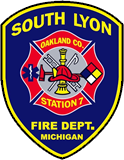Mission, Vision, and Core Values
Mission Statement
The South Lyon Fire Department is committed to providing fire suppression, medical services, and other emergency and non-emergency activities. We accomplish this mission through training, education, and dedication to the protection of our fire personnel, residents and visitors of the community.
Vision Statement
The South Lyon Fire Department will set the standard of excellence through professionalism, progressive practices, and customer service. We will create leaders through training, education, and strong ethical values. We will strive for industry best practices and excellence in emergency preparedness, response, and mitigation.
Core Values
We encourage and support excellence in leadership, innovation, and service to all. We aspire to the highest level of competency through training and mentoring. We value teamwork and open communication as the foundation for everything we do. We honor our families and the deep traditions of the Fire Service. We will act with respect and integrity in all situations.
Annual Reports
-
-
pdf
-
pdf
-
pdf
-
pdf
-
pdf
-
pdf
-
pdf
-
pdf
-
pdf
-
pdf
-
pdf
-
pdf
-
pdf
-
